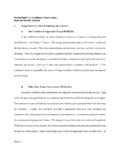Transcription of THE ROLE OF THE GENERAL CONTRACTOR IN SUSTAINABLE …
1 Int. Journal for Housing Science, , pp. 138-148, 2012 Published in the United States 0146-6518/03/138-148, 2012 Copyright 2012 IAHS THE ROLE OF THE GENERAL CONTRACTOR IN SUSTAINABLE GREEN BUILDINGS: The Case Study of Two Buildings in The Leed Certification in Italy A. Frattari, M. Dalpr Civil and Environmental Engineering Department (DICA) University of Trento, Trento, Italy e-mail: G. Salvaterra Martinatti construction , Arco, Italy e-mail: ABSTRACT The role of the GENERAL CONTRACTOR is fundamental to obtain the LEED (Leadership in Energy and Environmental Design) certification of a SUSTAINABLE green building.
2 The single most important aspect of the construction phase of a LEED project involves preparation and strict adherence to a site-specific LEED action plan. The plan addresses the process of ensuring compliance to LEED requirements from issuance of a subcontract until occupancy of the building. The LEED rating system assigns one prerequisite and several credits to the GENERAL CONTRACTOR in some environmental categories: SUSTAINABLE Sites, Materials and Resources and Indoor Environmental Quality. In the LEED certification, the GENERAL CONTRACTOR must not only use eco-friendly building materials, but he must also arrange a jobsite that minimally impacts on environmental matrices (water, air, soil and subsoil).
3 This is possible through the development and implementation of LEED construction plans involving the installation and continuous monitoring of specific measures and SUSTAINABLE construction practices. To illustrate the contributions that a qualified GENERAL CONTRACTOR can make towards the goal of LEED certification, in this paper we introduce the successful strategies 139 Frattari, M. Dalpr and Salvaterra employed at two projects recently designed and constructed in Italy to achieve high ratings under LEED rating systems. The paper describes the process in the basic phases and provides specific examples of jobsite strategies that were used on two different projects and with activities targeted towards particular points on the LEED matrix.
4 In particular the first case study is a project under the LEED New construction rating system and the second is a building under the LEED for Schools. Key words: Green Building, Eco-Friendly Building Materials, SUSTAINABLE construction Practices. Introduction Leadership in Energy and Environmental Design (LEED) is a registered trademark of the Green Building Council (USGBC). In 2000, USGBC established the LEED rating system as a way to define and measure green buildings. LEED is an internationally recognized green building certification system, providing third-party verification that measures how well a building performs across all the metrics that matter most: energy savings, water efficiency, CO2 emissions reduction, improved indoor environmental quality, and stewardship of resources and sensitivity to their impacts.
5 Points are awarded to meet LEED criteria according to the following scale: Certified, Silver, Gold, and Platinum. The quality of a building that aims for LEED certification is achieved at all stages of the building process: design, construction and building management. The LEED certification is the result of a synergic work of designers, contractors, owners and building users. A GC can provide input on aspects such as, material selection, system performance, decreasing construction waste, improving indoor air quality, The constructor can also assist in streamlining construction methods and constructability reviews in order to achieve the green project goals [1].
6 The adoption of the LEED rating system requires within the building firm a structured organization with clearly defined tasks and responsibilities to implement and verify the measures required by the LEED jobsite plans [2]. In addition to the implementation of the LEED jobsite plans, there is the constructor responsibility to select, purchase and install all the products that greatly contribute to the achievement of LEED credits regarding the building materials: reused building products, recycled content materials, materials extracted and manufactured at limited distance from the project site, rapidly renewable materials, low-emitting materials, certified wood, etc.
7 In particular, the LEED rating system assigns one prerequisite and several credits to SUSTAINABLE Green Buildings 140 the GC in some environmental categories: SUSTAINABLE Sites (SS), Materials & Resources (MR) and Indoor Environmental Quality (EQ), (see Figure 1). Figure 1 : Overview of LEED prerequisite and LEED credits typically of responsibility of GC Case studies To illustrate the contributions that a qualified GC can make towards the goal of LEED certification, in this paper we introduce the successful strategies employed at two projects recently constructed in Italy to achieve high ratings under LEED rating systems.
8 Since 2008, many Italian projects are achieving the LEED certification. Our case studies are two buildings built in Trentino region (Italy) in the period 2008-2011 by the Martinatti construction company. Currently (January 2012) both projects are under construction review (see Figure 2). The first one is the New multipurpose center of Ceole. The owner is Trentino Sviluppo Spa, an agency set up by the Autonomous Province of Trento for SUSTAINABLE development of the Trentino system, by taking action and providing services aimed at supporting the growth of business skills and the capacity for innovation.
9 The New multipurpose center of Ceole is a building of more 3000 square meters developed on 141 Frattari, M. Dalpr and Salvaterra several levels. The building includes offices, meeting rooms, a doctor s office, a coffee bar area, a canteen with 100 seats and a technical area where Trentino Network manages the distribution of the fiber optic service in perspective of all users of the Arco town. The certification goal is LEED gold under LEED NC The second one is the New elementary school of Romarzollo. The owner is the Municipality of Arco. This school is for 300 pupils.
10 The building includes 14 classrooms, 4 laboratory classrooms, common areas, canteen for 200 seats, gym and facilities for extracurricular activities. The total area is about 4720 square meters. The certification goal is LEED platinum/gold under LEED for School. Figure 2 : The New multipurpose center of Ceole and the New elementary school of Romarzollo (Arco-Italy). LEED action plan The GC plays a vital role in the ultimate success of achieving the LEED rating. This paper is focused on the LEED aspects of the three phases where the CONTRACTOR s involvement is fundamental: Pre- construction Phase construction Phase Closing Phase With regard to the Commissioning process, the Commissioning activities involve the GC and are completed during and after the construction Phase.







